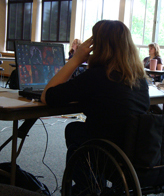Access to Electronic Resources
Development of sophisticated online multimedia resources has extended the reach of computers. Increasingly, however, these resources are not fully accessible to people with some types of disabilities. For example, screen reader software with a speech synthesizer used by a student who is blind cannot interpret graphics or video clips.
Background
The Americans with Disabilities Act (ADA) of 1990 requires that U.S. programs and services be accessible to individuals with disabilities. A 1996 Department of Justice ruling (www.usdoj.gov/crt/foia/cltr204.txt) makes it clear that ADA accessibility requirements apply to online resources.
Some students with visual impairments cannot see graphics, and some students who are deaf cannot hear audio. Some have difficulty when screens are unorganized, inconsistent, and cluttered and when descriptions and instructions are unclear. These difficulties may occur for students who have learning disabilities, speak English as a second language, or are poor readers. Other students use older equipment or slow connections or modems that limit their access to multimedia features.
As more information is delivered electronically, schools play an increasingly important role in ensuring access to online resources for all students. When evaluating the accessibility of a school's electronic resources, consider tutorials, application software, databases, and full-text resources.
Electronic resources such as school and district web pages, online catalogs, and local digital library projects, should be developed with universal access as a goal. Accessibility guidelines should be incorporated into web development standards.
Consider accessibility when purchasing new electronic resources for the school. Ask the vendor if the product has been tested for accessibility and, specifically, if the product is compatible with screen reading software. Develop a policy that electronic products in your school be reviewed for accessibility before purchase. Make it a priority to buy and develop accessible resources. Then, as a backup, be prepared to assist students to access electronic resources that they cannot access independently.
Universal Design Principles
In developing accessible electronic resources, principles of universal design (UD) should be employed. This approach will help ensure that all students will be able to independently utilize your electronic resources, regardless of their disabilities or the limitations of their equipment and software.
Typically, organizations design their electronic services for the average user. UD means that they are designed for people with a broad range of abilities and disabilities. The National Center on Universal Design has defined UD as "the design of products and environments to be usable by all people, to the greatest extent possible, without the need for adaptation or specialized design" (www.design.ncsu.edu/cud/about_ud/about_ud.htm).
Universal design principles can be applied to both facilities and tools. They are especially appropriate to consider when designing electronic resources, including online catalogs, software, and web resources. Adapted from a listing by the Center for Universal Design (CUD) at North Carolina State University, here are some general guidelines to consider in designing an electronic resource.
- Equitable use. The design is useful and marketable to people with diverse abilities. Example: A professor's website is designed so that it is accessible to everyone, including students who are blind and using text-to-speech software.
- Flexibility in use. The design accommodates a wide range of individual preferences and abilities. Example: A museum, visited as a field trip for a course, allows each student to choose to read or listen to a description of the contents of display cases.
- Simple and intuitive use. Use of the design is easy to understand, regardless of the user's experience, knowledge, language skills, or current concentration level. Example: Control buttons on science equipment are labeled with text and symbols that are simple and intuitive to understand.
- Perceptible information. The design communicates necessary information effectively to the user, regardless of ambient conditions or the user's sensory abilities. Example: A video presentation projected in a course includes captions.
- Tolerance for error. The design minimizes hazards and the adverse consequences of accidental or unintended actions. Example: Educational software provides guidance and background information when the student makes an inappropriate response.
- Low physical effort. The design can be used efficiently, comfortably, and with a minimum of fatigue. Example: Doors to a lecture hall open automatically for people with a wide variety of physical characteristics.
- Size and space for approach and use. Appropriate size and space is provided for approach, reach, manipulation, and use regardless of the user's body size, posture, or mobility. Example: A flexible science lab work area has adequate workspace for students who are left- or right-handed and for those who need to work from a standing or seated position.
Accessibility Guidelines
The World Wide Web Consortium (W3C) develops and maintains the protocols used on the web to insure interoperability to promote universal access. W3C's Web Accessibility Initiative (WAI) has proposed guidelines for all web authors. As Tim Berners-Lee, director of W3C, puts it, "The power of the web is in its universality. Access by everyone regardless of disability is an essential aspect" (www.w3.org/WAI).
In 2001, as a response to Section 508 of the Rehabilitation Act, the U.S. Architectural and Transportation Barriers Compliance Board (Access Board) developed accessibility standards for information technology developed, procured, or used by federal agencies. The list of guidelines for accessibility provides a good model even for organizations that are not required to comply.
In most school districts, many people develop web content. Building web content that is consistent, accessible, and usable can be a challenge. To ensure school-wide development of accessible web pages, consider adopting standards or guidelines that are useful and well explained. This may be as complex as constructing a set of guidelines from scratch or as simple as adopting the Section 508 web accessibility standards. Disseminate information about the standards to all web developers in the district, and provide resources, training, and technical support on an ongoing basis.
Accessible Web Design

In this section, we'll apply universal design principles to a common activity in schools today: designing web pages. The Internet provides a huge network of educational, governmental, and commercial resources to all people. Most schools maintain their own websites. Yet because of the multimedia nature of the medium, some users cannot access some materials available on the web.
View the video, World Wide Access: Accessible Web Design, in which students with disabilities and practitioners share access problems and solutions. Examples of design features for making web pages accessible are described. These recommendations are covered in the handout World Wide Access: Accessible Web Design. Read this publication for more accessible design examples. If you have not created a web page before, you may be confused by some of the technical jargon used in the video and handout. If so, don't be discouraged. Focus on the basic principles, and pass the information on to staff, students, and administrators responsible for web page development at your school.
In the next few paragraphs we'll provide a few simple examples of accessible web design. An important principle to remember is to maintain a simple, consistent page layout throughout your site. Much of the power and appeal of the web comes from the fact that it presents information in a variety of formats while also organizing that information through hypertext links. Designing a well-organized site with a consistent design makes it easier for visitors to find the information they need. In particular, it benefits people with learning disabilities and attention deficits who have difficulty following disorganized presentations.
Think about the physical effort needed to use your site. Remember that small buttons marking links can be difficult targets for visitors with mobility impairments that result in restricted hand movements. Larger buttons make it easier for all visitors to select the links on your page. Along with a consistent page layout, it is important to keep backgrounds simple and make sure there is enough contrast.
Many background images and colors obscure text and make reading difficult. Make sure that there is enough contrast between your text and the background of the page. Choose background, text, and link colors carefully, and always test your site with a variety of browsers and monitors. Following this guideline will aid visitors with low vision, color blindness, and those with learning disabilities who can find busy backgrounds and moving features from page to page confusing.
Visitors who use screen-reading software with speech output can adjust their software to read only the links on a page. For this reason, links should provide enough information when read out of context. For example, never use "Click here" as a link or next to a graphic used as a link. Make links descriptive enough that they are understood out of context.
HyperText Markup Language (HTML) is the standardized code used to create websites. The code works with tags that tell a web browser where to find and how to display your information. HTML was designed to be a universal format outside the bounds of proprietary software and computer languages. The W3C specifies what is standard HTML, with the intent of maintaining a language compatible with many platforms and browsers.
The universal format of the Internet meets the equitable and flexible principles of universal design. However, many people like to use new and nonstandard features on their web pages. Such actions obstruct the original purpose of a worldwide standard and the open communication that it allows and encourages.
Using standard HTML tags will ensure that your content can be accessed by all browsers used by visitors to your site. Avoid tags such as
Notify site visitors that you are concerned about accessibility by including a statement about accessibility on your page. Encourage site visitors to notify you with their accessibility concerns. For example, the DO-IT home page includes this statement:
The DO-IT pages form a living document and are regularly updated.We strive to make them universally accessible. We minimize the use of graphics and photos, and provide descriptions of them when they are included. Video clips are open-captioned, providing access to users who can't hear the audio. Suggestions for increasing the accessibility of these pages are welcome.
People who are blind cannot view the graphical features of your website. Many people with visual impairments use voice output programs with text-based browsers or graphical browsers with the feature that loads images turned off. Include text alternatives to make the content in these graphical features accessible. This practice addresses the universal design strategy to provide redundant information in different modes of presentation.
Some people have advocated the use of alternative text versions of websites that are graphic-intensive. However, this approach adds a great deal of maintenance time and complexity, since two versions must be updated. The maintenance time increases exponentially for organizations that provide their sites in multiple language versions. Therefore, it is best to make every effort to create the original version in an accessible format. Remember, that an important principle of universal design is equitable use, so avoid segregating users of your electronic resources by their ability, the connection speed, or the type of hardware and software they use.
Get started by including short, descriptive "alt" attributes for graphical features on your page. An alt attribute is an HTML parameter used with the element to provide a text alternative to graphical content. With alternate text, users who can't see the graphics (e.g., screen reader users, text browser users, sighted users with images turned off) can still access the content.
For example, when a sighted visitor views the DO-IT home page at https://www.washington.edu/doit/ with a graphical browser, they will see the DO-IT logo. When a user who is blind visits, the computer's voice output program will read "DO-IT logo" because DO-IT staff used this text as an alt attribute for the graphic. This gives the user a clear idea of what is on the page. Any visitor coming to the site using a text-based browser will understand that there is a logo there instead of the more ambiguous "image" that is the default result when no alt attribute is used.
This example can also be used to explain the difference between text and words embedded in a graphic. Web designers sometimes embed text in graphics so that they can incorporate color, fancy fonts, and other design elements into the display. It is important to differentiate between text, which screen readers can access, and words that are images, which screen readers cannot read. In the DO-IT logo, "DO-IT" is an image. DO-IT staff include "DO-IT" in the alt attribute so that the DO-IT name is displayed by a text browser and read by a speech synthesizer.
A related accessible design rule is to use menu alternatives for image maps to ensure that the embedded links are accessible. An image map is a picture on which areas can be clicked to find a link to another page. For example, a site with information on state trivia presents a map of the United States. When using a graphical browser such as Internet Explorer, a visitor can choose information by clicking on a state image. However, if the web page developer has not included an alternative text-based menu, visitors using text-based browsers may only be able to read or hear this:
States Trivia
[ismap]
At this point the visitor is stuck, since text-based browsers will not interpret the hypertext links embedded in the image map. Accessibility of image maps may involve providing attributes for every hyperlink in an image map or navigation menu, or a listing of hypertext links above or below the image map.
Including alt attributes is sufficient for logos and graphics that are not critical to the information content of the page. But if the graphics provide information beyond this, adding captions and transcriptions is important for those who cannot see your page because they are using a text-based browser, possibly because they are blind. Include descriptive captions for photographs and pictures. Provide enough detail so that a visitor who cannot see the pictures will understand the content that the images add to the page. If you present information embedded in an image format (e.g., PDF), such as a scanned-in image of a page of a manuscript, be sure to also include a transcription of the manuscript in a text format. This practice benefits many visitors, including those with visual impairments, users who speak English as a second language, and those with learning disabilities. Again, think redundancy.
Multimedia and audio formats can present barriers to people with hearing impairments and to people with less sophisticated computer systems. Provide captions and/or transcriptions for spoken materials so these visitors have an alternative method of accessing this information.
New accessibility issues have emerged as the web is changing from static pages to a dynamic, interactive social space. For example, Flash applications are inaccessible to individuals who are blind and using screen reader and speech output technology. It is wise for web designers to use Flash when specific features such as animation are desired, avoid using it for navigation features, and provide alternatives for important content presented with Flash.
Consult the AccessWeb website for links to resources on accessible web design.

Web Page Tests
Test your web pages with as many web browsers as you can. Always use at least one text-based browser. This way, you will see your web resources from the many perspectives of your users.
Part of testing your website includes running it against an HTML validator program. These programs compare the HTML at your site with the rules of standard HTML. They generate a report listing errors and nonstandard tags. Some validators check specifically for accessibility. Try using an accessibility validation site, which performs a diagnostic on your pages and points out parts that could be inaccessible.
Teaching Students About Accessible Web Design
If you are teaching a course on web design or assigning to students the development of web pages in another course, consider requiring that students produce accessible products. Consult the publication Universal Design of Web Pages in Class Projects for ideas about how to incorporate accessible web design into your curriculum.

Tip: Access to Electronic Resources
In the Presentations section of this notebook, you will find guidelines and materials for delivering a presentation on access to electronic resources.
Whether you are developing electronic resources or designing a lab for your school, apply universal design principles to maximize access. In particular, consider these accessible web design principles when developing web pages.
- Maintain a simple, consistent page layout.
- Keep backgrounds simple. Make sure there is enough contrast.
- Use standard HTML.
- Include a note about accessibility.
- Provide text alternatives (alt attributes, captions, alternative menus, transcriptions) for graphical features.
- Use special features with care.
- Test your web pages with a variety of browsers.
Schools have a moral and legal responsibility to make computing resources accessible to students and community members with disabilities. They must provide accessible buildings, computers, and electronic resources. You should also demand from vendors that the products you purchase employ access features. Administrators can access further instruction for adopting and implementing web accessibility policies and procedures in their schools by consulting the publication Web Accessibility: Guidelines for Administrators.